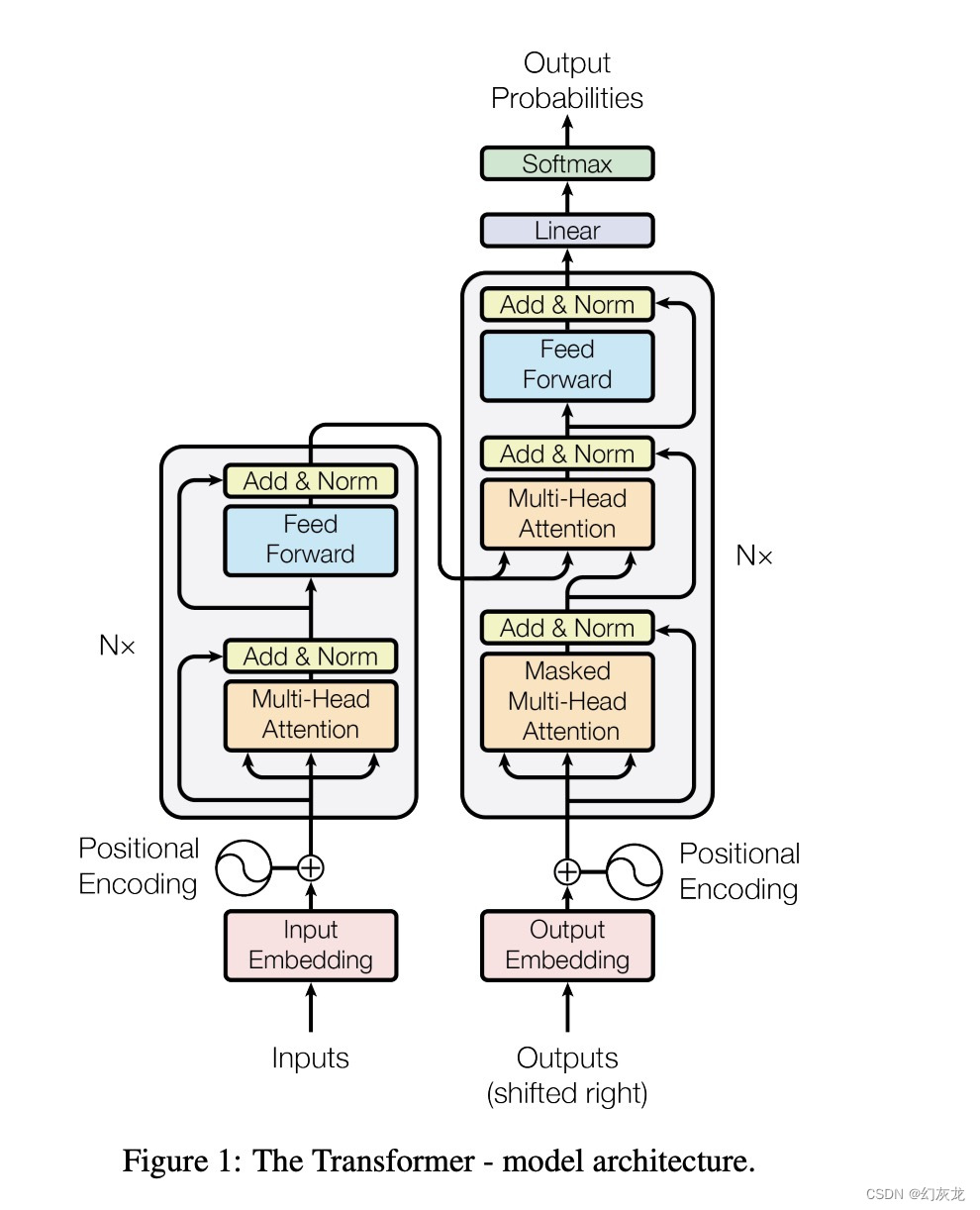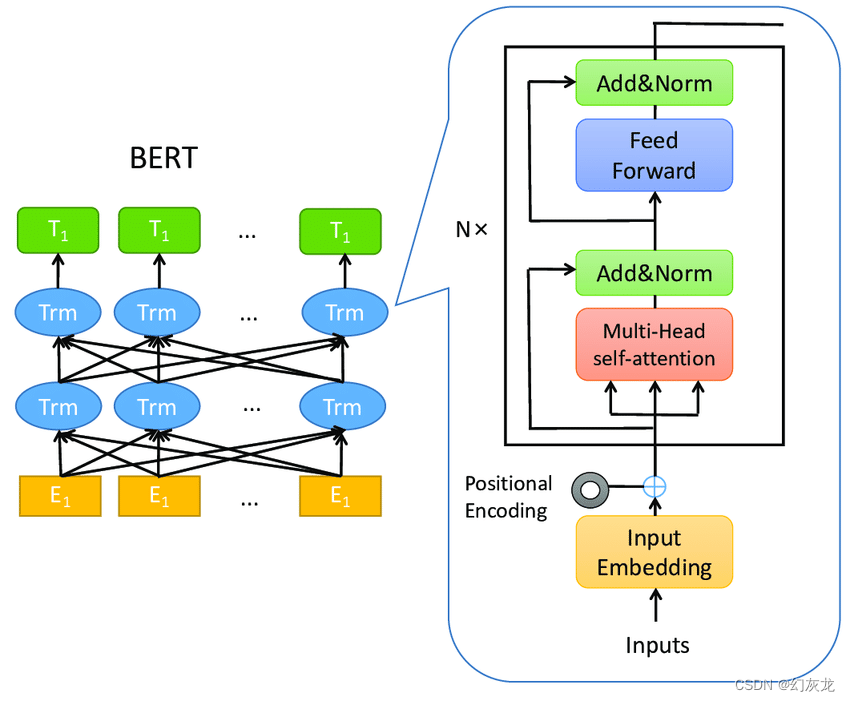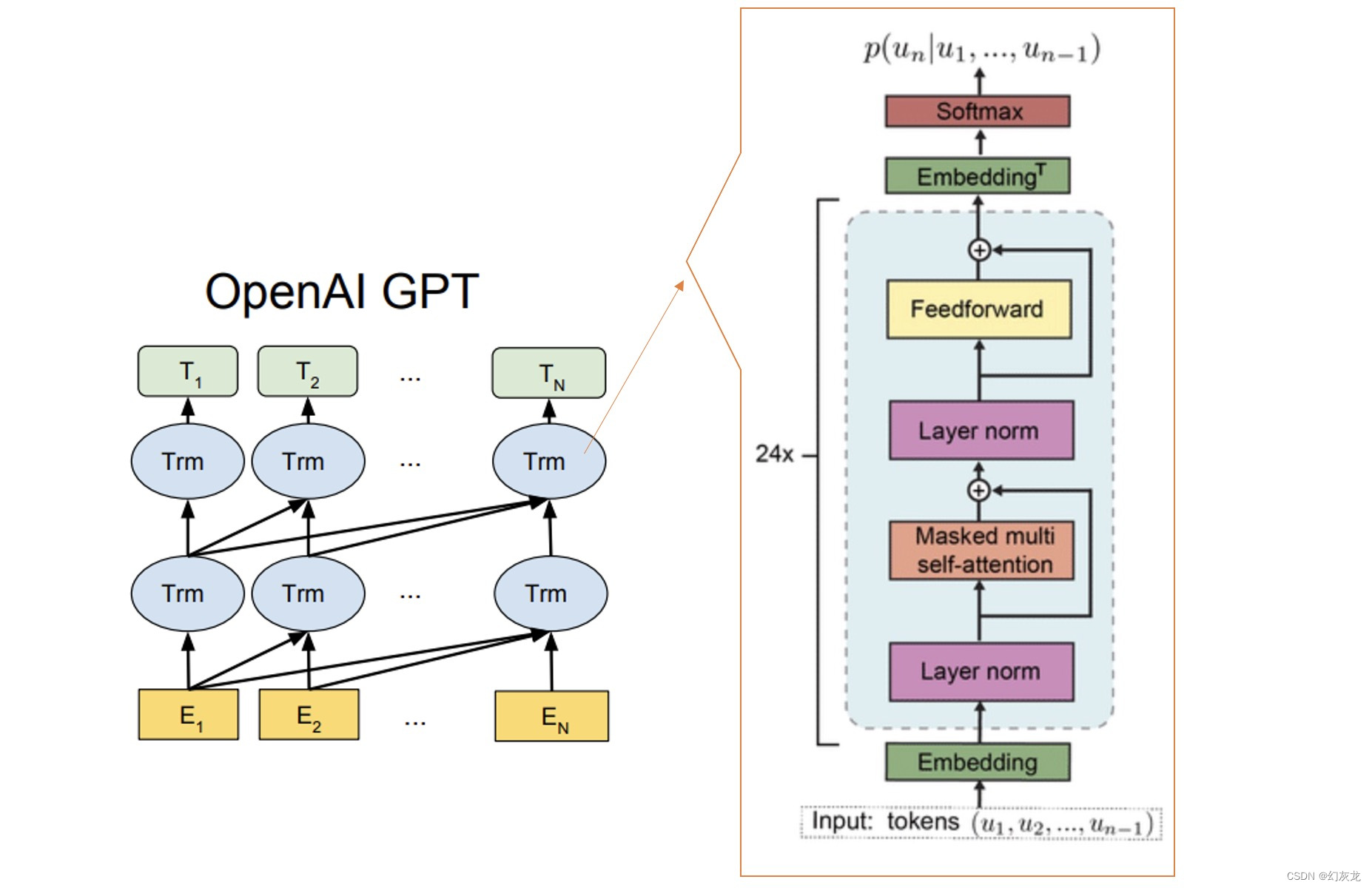热门标签
热门文章
- 1内网渗透初探(三) | 查缺补漏_secretsdump.py
- 2vue从url中获取token并加入到 请求头里_django开发-django中实现用户登录认证的几种方式...
- 3自己搭建gitlab token没有写权限_gitlab迁移
- 4JavaScript的OO特性:静态方法
- 5Mac查看本机IP_mac ifconfig
- 6分享几个可以免费使用GPT的网站_免费gpt
- 7一文理解 Redis 持久化:RDB和AOF_rdb与aof结合一起做恢复
- 8[开源]基于 Flowable 的工作流管理平台,易集成、高度可定制、扩展性强_flowable开源
- 9计算机网络——IP协议基础原理_ip协议原理
- 10FPGA设计的指导性原则 (一)_fpga板卡design rule
当前位置: article > 正文
让chatGPT使用Tensor flow Keras组装Bert,GPT,Transformer_chatgpt和tensorflow
作者:神奇cpp | 2024-06-21 23:41:42
赞
踩
chatgpt和tensorflow
让chatGPT使用Tensor flow Keras组装Bert,GPT,Transformer
本文主要展示Transfomer, Bert, GPT的神经网络结构之间的关系和差异。网络上有很多资料,但是把这个关系清晰展示清楚的不多。本文作为一个补充资料组织,同时利用chatGPT,让它使用Tensor flow Keras 来组装对应的迷你代码辅助理解。
从这个组装,可以直观的看到:
- Transformer: Encoder-Decoder 模块都用到了
- Bert: 只用到了Transformer的Encoder来作模块组装
- GPT: 只用到了Transformer的Decoder来做模块的组装
implement Transformer Model by Tensor flow Keras

网上有大量讲解Transformer每层做什么的事情,这个可以单独一篇文章拆解我的理解。本文档假设在这点上读者已经理解了。
import tensorflow as tf class Transformer(tf.keras.Model): def __init__(self, num_layers, d_model, num_heads, d_ff, input_vocab_size, target_vocab_size, dropout_rate=0.1): super(Transformer, self).__init__() self.encoder = Encoder(num_layers, d_model, num_heads, d_ff, input_vocab_size, dropout_rate) self.decoder = Decoder(num_layers, d_model, num_heads, d_ff, target_vocab_size, dropout_rate) self.final_layer = tf.keras.layers.Dense(target_vocab_size) def call(self, inputs, targets, enc_padding_mask, look_ahead_mask, dec_padding_mask): enc_output = self.encoder(inputs, enc_padding_mask) dec_output = self.decoder(targets, enc_output, look_ahead_mask, dec_padding_mask) final_output = self.final_layer(dec_output) return final_output class Encoder(tf.keras.layers.Layer): def __init__(self, num_layers, d_model, num_heads, d_ff, vocab_size, dropout_rate=0.1): super(Encoder, self).__init__() self.num_layers = num_layers self.embedding = tf.keras.layers.Embedding(vocab_size, d_model) self.positional_encoding = PositionalEncoding(vocab_size, d_model) self.encoder_layers = [EncoderLayer(d_model, num_heads, d_ff, dropout_rate) for _ in range(num_layers)] self.dropout = tf.keras.layers.Dropout(dropout_rate) def call(self, inputs, padding_mask): embedded_input = self.embedding(inputs) positional_encoded_input = self.positional_encoding(embedded_input) encoder_output = self.dropout(positional_encoded_input) for i in range(self.num_layers): encoder_output = self.encoder_layers[i](encoder_output, padding_mask) return encoder_output class Decoder(tf.keras.layers.Layer): def __init__(self, num_layers, d_model, num_heads, d_ff, vocab_size, dropout_rate=0.1): super(Decoder, self).__init__() self.num_layers = num_layers self.embedding = tf.keras.layers.Embedding(vocab_size, d_model) self.positional_encoding = PositionalEncoding(vocab_size, d_model) self.decoder_layers = [DecoderLayer(d_model, num_heads, d_ff, dropout_rate) for _ in range(num_layers)] self.dropout = tf.keras.layers.Dropout(dropout_rate) def call(self, inputs, encoder_output, look_ahead_mask, padding_mask): embedded_input = self.embedding(inputs) positional_encoded_input = self.positional_encoding(embedded_input) decoder_output = self.dropout(positional_encoded_input) for i in range(self.num_layers): decoder_output = self.decoder_layers[i](decoder_output, encoder_output, look_ahead_mask, padding_mask) return decoder_output class EncoderLayer(tf.keras.layers.Layer): def __init__(self, d_model, num_heads, d_ff, dropout_rate=0.1): super(EncoderLayer, self).__init__() self.multi_head_attention = MultiHeadAttention(d_model, num_heads) self.ffn = FeedForwardNetwork(d_model, d_ff) self.layer_norm1 = tf.keras.layers.LayerNormalization(epsilon=1e-6) self.layer_norm2 = tf.keras.layers.LayerNormalization(epsilon=1e-6) self.dropout1 = tf.keras.layers.Dropout(dropout_rate) self.dropout2 = tf.keras.layers.Dropout(dropout_rate) def call(self, inputs, padding_mask): attention_output = self.multi_head_attention(inputs, inputs, inputs, padding_mask) attention_output = self.dropout1(attention_output) attention_output = self.layer_norm1(inputs + attention_output) ffn_output = self.ffn(attention_output) ffn_output = self.dropout2(ffn_output) encoder_output = self.layer_norm2(attention_output + ffn_output) return encoder_output class DecoderLayer(tf.keras.layers.Layer): def __init__(self, d_model, num_heads, d_ff, dropout_rate=0.1): super(DecoderLayer, self).__init__() self.multi_head_attention1 = MultiHeadAttention(d_model, num_heads) self.multi_head_attention2 = MultiHeadAttention(d_model, num_heads) self.ffn = FeedForwardNetwork(d_model, d_ff) self.layer_norm1 = tf.keras.layers.LayerNormalization(epsilon=1e-6) self.layer_norm2 = tf.keras.layers.LayerNormalization(epsilon=1e-6) self.layer_norm3 = tf.keras.layers.LayerNormalization(epsilon=1e-6) self.dropout1 = tf.keras.layers.Dropout(dropout_rate) self.dropout2 = tf.keras.layers.Dropout(dropout_rate) self.dropout3 = tf.keras.layers.Dropout(dropout_rate) def call(self, inputs, encoder_output, look_ahead_mask, padding_mask): attention1_output = self.multi_head_attention1(inputs, inputs, inputs, look_ahead_mask) attention1_output = self.dropout1(attention1_output) attention1_output = self.layer_norm1(inputs + attention1_output) attention2_output = self.multi_head_attention2(attention1_output, encoder_output, encoder_output, padding_mask) attention2_output = self.dropout2(attention2_output) attention2_output = self.layer_norm2(attention1_output + attention2_output) ffn_output = self.ffn(attention2_output) ffn_output = self.dropout3(ffn_output) decoder_output = self.layer_norm3(attention2_output + ffn_output) return decoder_output class MultiHeadAttention(tf.keras.layers.Layer): def __init__(self, d_model, num_heads): super(MultiHeadAttention, self).__init__() self.num_heads = num_heads self.d_model = d_model self.depth = d_model // num_heads self.wq = tf.keras.layers.Dense(d_model) self.wk = tf.keras.layers.Dense(d_model) self.wv = tf.keras.layers.Dense(d_model) self.dense = tf.keras.layers.Dense(d_model) def split_heads(self, x, batch_size): x = tf.reshape(x, (batch_size, -1, self.num_heads, self.depth)) return tf.transpose(x, perm=[0, 2, 1, 3]) def call(self, query, key, value, mask): batch_size = tf.shape(query)[0] q = self.wq(query) k = self.wk(key) v = self.wv(value) q = self.split_heads(q, batch_size) k = self.split_heads(k, batch_size) v = self.split_heads(v, batch_size) scaled_attention, attention_weights = scaled_dot_product_attention(q, k, v, mask) scaled_attention = tf.transpose(scaled_attention, perm=[0, 2, 1, 3]) concat_attention = tf.reshape(scaled_attention, (batch_size, -1, self.d_model)) output = self.dense(concat_attention) return output, attention
- 1
- 2
- 3
- 4
- 5
- 6
- 7
- 8
- 9
- 10
- 11
- 12
- 13
- 14
- 15
- 16
- 17
- 18
- 19
- 20
- 21
- 22
- 23
- 24
- 25
- 26
- 27
- 28
- 29
- 30
- 31
- 32
- 33
- 34
- 35
- 36
- 37
- 38
- 39
- 40
- 41
- 42
- 43
- 44
- 45
- 46
- 47
- 48
- 49
- 50
- 51
- 52
- 53
- 54
- 55
- 56
- 57
- 58
- 59
- 60
- 61
- 62
- 63
- 64
- 65
- 66
- 67
- 68
- 69
- 70
- 71
- 72
- 73
- 74
- 75
- 76
- 77
- 78
- 79
- 80
- 81
- 82
- 83
- 84
- 85
- 86
- 87
- 88
- 89
- 90
- 91
- 92
- 93
- 94
- 95
- 96
- 97
- 98
- 99
- 100
- 101
- 102
- 103
- 104
- 105
- 106
- 107
- 108
- 109
- 110
- 111
- 112
- 113
- 114
- 115
- 116
- 117
- 118
- 119
- 120
- 121
- 122
- 123
- 124
- 125
- 126
- 127
- 128
- 129
- 130
- 131
- 132
- 133
- 134
- 135
- 136
- 137
- 138
- 139
- 140
- 141
- 142
- 143
- 144
- 145
- 146
- 147
- 148
- 149
- 150
implement Bert model by Tensor flow Keras

其中,左侧的每个Trm代表,右侧的放大图,也就是原始Transformer的Encoder部分结构。同时可以看到,Bert在左侧中,是双向组装Transformer的。Bert的训练任务包括MLM(Masked Language Model)和NSP(Next Sentence Prediction). Bert的训练是无监督的,因为MLM实际上就是将语料的某些Token遮挡起来,那么输出结果需要知道答案是什么(标注信息)实际上就包含在语料里。从这个角度来说,实际上也是监督的。
import tensorflow as tf class BERT(tf.keras.Model): def __init__(self, vocab_size, hidden_size, num_attention_heads, num_transformer_layers, intermediate_size): super(BERT, self).__init__() self.embedding = tf.keras.layers.Embedding(vocab_size, hidden_size) self.transformer_layers = [TransformerLayer(hidden_size, num_attention_heads, intermediate_size) for _ in range(num_transformer_layers)] self.dropout = tf.keras.layers.Dropout(0.1) def call(self, inputs, attention_mask): embedded_input = self.embedding(inputs) hidden_states = embedded_input for transformer_layer in self.transformer_layers: hidden_states = transformer_layer(hidden_states, attention_mask) hidden_states = self.dropout(hidden_states) return hidden_states class TransformerLayer(tf.keras.layers.Layer): def __init__(self, hidden_size, num_attention_heads, intermediate_size): super(TransformerLayer, self).__init__() self.attention = MultiHeadAttention(hidden_size, num_attention_heads) self.feed_forward = FeedForward(hidden_size, intermediate_size) self.layer_norm1 = tf.keras.layers.LayerNormalization(epsilon=1e-6) self.layer_norm2 = tf.keras.layers.LayerNormalization(epsilon=1e-6) self.dropout1 = tf.keras.layers.Dropout(0.1) self.dropout2 = tf.keras.layers.Dropout(0.1) def call(self, inputs, attention_mask): attention_output = self.attention(inputs, inputs, inputs, attention_mask) attention_output = self.dropout1(attention_output) attention_output = self.layer_norm1(inputs + attention_output) feed_forward_output = self.feed_forward(attention_output) feed_forward_output = self.dropout2(feed_forward_output) layer_output = self.layer_norm2(attention_output + feed_forward_output) return layer_output class MultiHeadAttention(tf.keras.layers.Layer): def __init__(self, hidden_size, num_attention_heads): super(MultiHeadAttention, self).__init__() self.num_attention_heads = num_attention_heads self.attention_head_size = hidden_size // num_attention_heads self.query = tf.keras.layers.Dense(hidden_size) self.key = tf.keras.layers.Dense(hidden_size) self.value = tf.keras.layers.Dense(hidden_size) self.dense = tf.keras.layers.Dense(hidden_size) def call(self, query, key, value, attention_mask): query = self.query(query) key = self.key(key) value = self.value(value) query = self._split_heads(query) key = self._split_heads(key) value = self._split_heads(value) attention_scores = tf.matmul(query, key, transpose_b=True) attention_scores /= tf.math.sqrt(tf.cast(self.attention_head_size, attention_scores.dtype)) if attention_mask is not None: attention_scores += attention_mask attention_probs = tf.nn.softmax(attention_scores, axis=-1) context_layer = tf.matmul(attention_probs, value) context_layer = tf.transpose(context_layer, perm=[0, 2, 1, 3]) context_layer = tf.reshape(context_layer, (tf.shape(context_layer)[0], -1, hidden_size)) attention_output = self.dense(context_layer) return attention_output def _split_heads(self, x): batch_size = tf.shape(x)[0] length = tf.shape(x)[1] x = tf.reshape(x, (batch_size, length, self.num_attention_heads,
- 1
- 2
- 3
- 4
- 5
- 6
- 7
- 8
- 9
- 10
- 11
- 12
- 13
- 14
- 15
- 16
- 17
- 18
- 19
- 20
- 21
- 22
- 23
- 24
- 25
- 26
- 27
- 28
- 29
- 30
- 31
- 32
- 33
- 34
- 35
- 36
- 37
- 38
- 39
- 40
- 41
- 42
- 43
- 44
- 45
- 46
- 47
- 48
- 49
- 50
- 51
- 52
- 53
- 54
- 55
- 56
- 57
- 58
- 59
- 60
- 61
- 62
- 63
- 64
- 65
- 66
- 67
- 68
- 69
- 70
- 71
- 72
- 73
- 74
- 75
- 76
- 77
- 78
- 79
- 80
implement GPT model by Tensor flow Keras

其中,左侧的每个Trm放大都是右侧的部分,也就是Transfomer原始结构里的Decoder部分。同时可以看到,GPT在左侧中,是单向组装Transformer的。GPT的训练任务就是生成下一个Token。GPT是无监督的,因为从机器学习的角度,输出数据需要的「标注信息」(下一个Token)就是语料已经提供的。从这个角度来说,其实也是监督的。
import tensorflow as tf class GPT(tf.keras.Model): def __init__(self, vocab_size, hidden_size, num_layers, num_heads, intermediate_size, max_seq_length): super(GPT, self).__init__() self.embedding = tf.keras.layers.Embedding(vocab_size, hidden_size) self.positional_encoding = PositionalEncoding(max_seq_length, hidden_size) self.transformer_blocks = [TransformerBlock(hidden_size, num_heads, intermediate_size) for _ in range(num_layers)] self.final_layer_norm = tf.keras.layers.LayerNormalization(epsilon=1e-6) self.final_dense = tf.keras.layers.Dense(vocab_size, activation='softmax') def call(self, inputs): embedded_input = self.embedding(inputs) positional_encoded_input = self.positional_encoding(embedded_input) hidden_states = positional_encoded_input for transformer_block in self.transformer_blocks: hidden_states = transformer_block(hidden_states) final_output = self.final_layer_norm(hidden_states) final_output = self.final_dense(final_output) return final_output class TransformerBlock(tf.keras.layers.Layer): def __init__(self, hidden_size, num_heads, intermediate_size): super(TransformerBlock, self).__init__() self.attention = MultiHeadAttention(hidden_size, num_heads) self.feed_forward = FeedForward(hidden_size, intermediate_size) self.layer_norm1 = tf.keras.layers.LayerNormalization(epsilon=1e-6) self.layer_norm2 = tf.keras.layers.LayerNormalization(epsilon=1e-6) def call(self, inputs): attention_output = self.attention(inputs, inputs, inputs) attention_output = self.layer_norm1(inputs + attention_output) feed_forward_output = self.feed_forward(attention_output) layer_output = self.layer_norm2(attention_output + feed_forward_output) return layer_output class MultiHeadAttention(tf.keras.layers.Layer): def __init__(self, hidden_size, num_heads): super(MultiHeadAttention, self).__init__() self.num_heads = num_heads self.attention_head_size = hidden_size // num_heads self.query = tf.keras.layers.Dense(hidden_size) self.key = tf.keras.layers.Dense(hidden_size) self.value = tf.keras.layers.Dense(hidden_size) self.dense = tf.keras.layers.Dense(hidden_size) def call(self, query, key, value): query = self.query(query) key = self.key(key) value = self.value(value) query = self._split_heads(query) key = self._split_heads(key) value = self._split_heads(value) attention_scores = tf.matmul(query, key, transpose_b=True) attention_scores /= tf.math.sqrt(tf.cast(self.attention_head_size, attention_scores.dtype)) attention_probs = tf.nn.softmax(attention_scores, axis=-1) context_layer = tf.matmul(attention_probs, value) context_layer = tf.transpose(context_layer, perm=[0, 2, 1, 3]) context_layer = tf.reshape(context_layer, (tf.shape(context_layer)[0], -1, hidden_size)) attention_output = self.dense(context_layer) return attention_output def _split_heads(self, x): batch_size = tf.shape(x)[0] length = tf.shape(x)[1] x = tf.reshape(x, (batch_size, length, self.num_heads, self.attention_head_size)) return tf.transpose(x, perm=[0, 2, 1, 3])
- 1
- 2
- 3
- 4
- 5
- 6
- 7
- 8
- 9
- 10
- 11
- 12
- 13
- 14
- 15
- 16
- 17
- 18
- 19
- 20
- 21
- 22
- 23
- 24
- 25
- 26
- 27
- 28
- 29
- 30
- 31
- 32
- 33
- 34
- 35
- 36
- 37
- 38
- 39
- 40
- 41
- 42
- 43
- 44
- 45
- 46
- 47
- 48
- 49
- 50
- 51
- 52
- 53
- 54
- 55
- 56
- 57
- 58
- 59
- 60
- 61
- 62
- 63
- 64
- 65
- 66
- 67
- 68
- 69
- 70
- 71
- 72
- 73
- 74
- 75
- 76
- 77
- 78
声明:本文内容由网友自发贡献,版权归原作者所有,本站不承担相应法律责任。如您发现有侵权的内容,请联系我们。转载请注明出处:【wpsshop博客】
推荐阅读
相关标签



